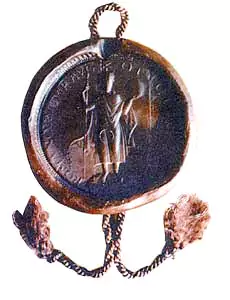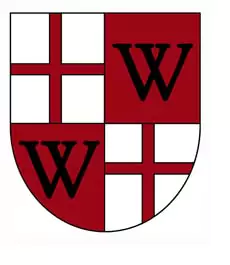Gerichtssiegel
Geschichte

Auf den Spuren von Wintrich
Das Gerichtssiegel von Wintrich ist über fünf Jahrhunderte auf vielen Urkunden nachgewiesen
„Das Wintricher Gericht besteht aus 14 Schöffen und war vorhin dem Vernehmen nach ein dem Vogt von Hunolstein zugehöriges Hochgericht (Gericht über schwere Straftaten, die an Leib und Leben gingen). Dasselbe erstreckt seine Gerichtsbarkeit über Wintrich, Minheim, Kesten und Filzen. Die 14 Schöffen werden aus diesen Orten hergenommen, und zwar aus Wintrich fünf, aus Minheim vier, aus Kesten drei und aus Filzen zwei. Ein derzeitiger kurfürstlicher Kellner von Bernkastel pflegt als Präses dieses Gerichts von ihrer kurfürstlichen Durchlaucht ernannt zu werden und den Gerichtstagen beizuwohnen. Wintrich war bis zur Säkularisation Mutterkirche von Filzen.
Bis etwa 1624 bildeten beide Ortschaften aber auch eine gemeinsame Zivilgemeinde, denn das Feuerstellenverzeichnis vom Jahr 1563 stellt fest: „Wintrich und Feltzen sind zwey Dörffer und ein Gemeindt“. In der Steuerliste von 1624 erscheint Filzen als selbständige Gemeinde. Seit dieser Zeit werden auch zwei Schöffen aus Filzen beim Gericht in Wintrich genannt, dessen Schöffenzahl selbst von sieben auf fünf reduziert wurde, da Filzen bis dahin keine Schöffen zum Wintricher Gericht entsandt hatte.
Bezüglich des Siegel-Symbols gibt es unterschiedliche Meinungen. Das Landeshauptarchiv in Koblenz bezeichnet dieses als „Dreiwirbel“ oder Windmühlenflügel. Verschiedene Historiker und Heimatforscher sehen in dem Siegel-Symbol ein Triskeles -tris, tres, drei- ein germanisch/keltisches Runen – die ältesten bekannten Schriftzeichen, die von allen germanischen Stämmen verwendet wurden. Wir finden dieses Zeichen, das meist zwischen drei und sechs Wirbel aufweist, auf vielen Geräten, auf Holz oder Stein eingeritzt, sehr oft auf Kampfschilden des 1. Jahrtausends n.Chr. Aber auch auf vorchristlichen keltischen Gold- und Silbermünzen finden wir dieses Symbol (siehe die beigefügten Abbildungen).
Ich möchte mich der Meinung dieser Fachleute anschließen und sehe auch in diesem Zeichen keine Ähnlichkeit mit „Windmühlenflügeln“. Wenn in Vindriacum, dem Keltendorf, sich die keltische Sprache bis in die Gegenwart erhalten hat, warum soll dann ein keltisches Schriftzeichen, ein Symbol für kultische und prophetische Zwecke, nicht vor 800 Jahren seinen Platz im Wintricher Gerichtssiegel gefunden haben?

Der Eichstempel des Eichamts Wintrich
Kurfürst Jakob III. von Eltz war es schließlich überdrüssig, immer wieder von den Klagen über das Durcheinander der Weinmaße an der Mosel zu hören. Deshalb reiste er höchst persönlich nach Bernkastel, um endlich Ordnung in das Gewirr der verschiedenen Maße zu bringen. Diese Reise fand im Jahre 1567 statt. Der Kurfürst ordnete an, dass in Bernkastel und in Wintrich Eichstellen einzurichten sind, die auf der Basis von 6 Maßen arbeiten sollen.
„Wein und alle anderen Waren, die man mit Weinmaßen zu messen und zu verkaufen pflegt, sollen 6 Teile haben, nämlich 1 ½ Ohm – das man einen Oxhoft (180 Quart) nennt. Es soll hierfür kein Weinmaß mit Ruten oder Schnüren geeicht oder gestochen werden, sondern wir wollen und gebieten allen unseren Untertanen Bernkasteler Amts und Hochgerichts, besonders denen, die am Moselstrom wohnen, dass sie alle Fässer zu Herbstzeiten und sonsten mit Wasser und einem Zuber von einem ganzen oder halben Ohm eichen und messen und wieviel ein jedes Fass hält, in dem Boden des Fasses ritzen und verzeichnen. Damit auch die aus der Fremde zureisenden Krämer unserer Untertanen nicht vervorteilt und vernachteilt werden.“ (Auszug aus der Verfügung des Kurfürsten).
Es ist das große Verdienst des Kurfürsten Jakob III. von Eltz, die „Eich“ eingeführt zu haben. Die Nachbarorte wurden damals der Eichstelle Wintrich zugeteilt, das ein eigenes Siegel erhielt.

- Geschichte, Kultur
